Business Law Report: BTEC HNC in Business - Unit 7 Assignment Analysis
VerifiedAdded on 2020/10/23
|10
|2571
|194
Report
AI Summary
This report provides a comprehensive overview of business law within the United Kingdom, examining the structure of the English legal system, including its constituents, sources, and divisions, alongside the organization of the justice system. It explores the role of the government in law-making and the organization of the judiciary. The report further analyzes the impact of various laws, such as contract law, competition law, data protection, and consumer protection, on business operations, including the duties of employers and employees. It delves into the formation of different types of business organizations, differentiating between incorporated and unincorporated businesses, and outlining the characteristics of sole traders, partnerships, and registered companies, including their classifications and management. The report also covers the processes of starting and registering a new business, capital raising, and liquidation, with a focus on the application of company law to different business types.
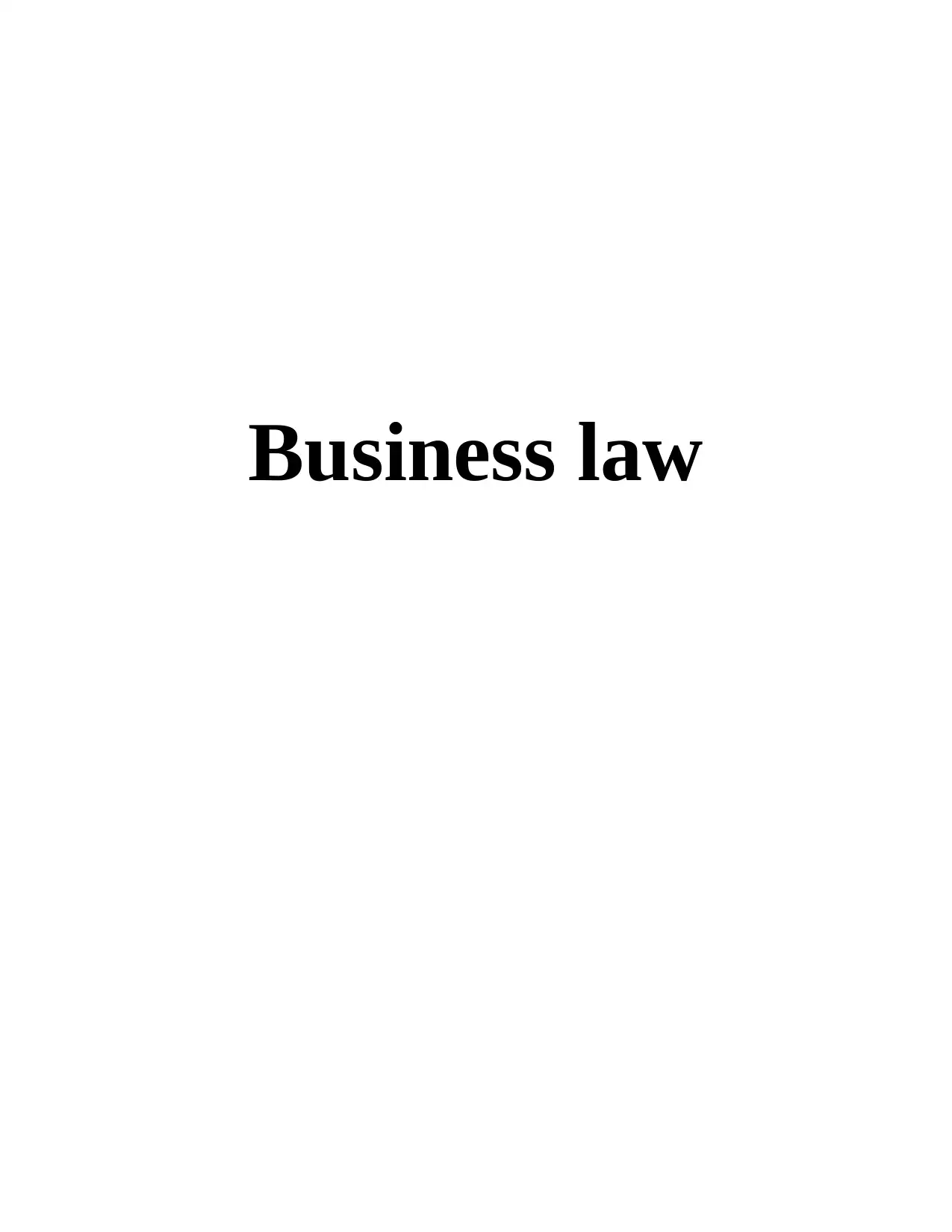
Business law
Paraphrase This Document
Need a fresh take? Get an instant paraphrase of this document with our AI Paraphraser

Table of Contents
INTRODUCTION...........................................................................................................................1
TASK 1............................................................................................................................................1
Legal system...........................................................................................................................1
................................................................................................................................................3
Justice system.........................................................................................................................4
Impact of law..........................................................................................................................4
Formation of different types of business organisation...........................................................5
TASK 2............................................................................................................................................7
CONCLUSION................................................................................................................................7
REFERENCES................................................................................................................................8
INTRODUCTION...........................................................................................................................1
TASK 1............................................................................................................................................1
Legal system...........................................................................................................................1
................................................................................................................................................3
Justice system.........................................................................................................................4
Impact of law..........................................................................................................................4
Formation of different types of business organisation...........................................................5
TASK 2............................................................................................................................................7
CONCLUSION................................................................................................................................7
REFERENCES................................................................................................................................8

INTRODUCTION
The business or commercial law is that body of law that governs the operations of a
business organisation through application of various laws and statues. In the present report a
discussion related with English legal system, its constituents, source of law, organisation justice
is carried out. Along with this different type of business organisation present in the UK with the
information of their funding and management is presented. Along with the implication various
type of laws have on the organisation is outlines with the consequences of non adhering with
them.
TASK 1
Legal system
Constituents: The English legal system have main components as common and statutory
law. The common laws is a body of law which is made form the decision in the judicial court.
The statutory law are made through legislature both primary and delegated.
Purpose: the purpose of having a definite legal system in the UK is to establish certain
rules and guidelines for directing the conduct of business as well as citizens. Moreover, the legal
system serve the purpose of providing formal means for resolving the disputes through the court
system.
Evolution: The English legal system is too old and it is in existences from more than 90
years. It has evolved over times as from the 12th century in them main source of law were the
case laws and with time the legislation also become the sources of law (Knapp, Crystal and
Prince, 2019). With this the court structure have been made more definite and particular to solve
the disputes.
Sources of law-making:
Legislation: this is main source of laws under which laws are made through the act of
parliaments and the authorities given as primary legislation to the parliament. There is also
secondary legislation where the public authorities, local bodies and ministers are give power by
the parliament to make laws.
Directives: are the legal act of the European Union which all the members states are
required to achieve. UK being still a part of EU gets its laws from EU directives such as
consumers Rights Act, 2015.
1
The business or commercial law is that body of law that governs the operations of a
business organisation through application of various laws and statues. In the present report a
discussion related with English legal system, its constituents, source of law, organisation justice
is carried out. Along with this different type of business organisation present in the UK with the
information of their funding and management is presented. Along with the implication various
type of laws have on the organisation is outlines with the consequences of non adhering with
them.
TASK 1
Legal system
Constituents: The English legal system have main components as common and statutory
law. The common laws is a body of law which is made form the decision in the judicial court.
The statutory law are made through legislature both primary and delegated.
Purpose: the purpose of having a definite legal system in the UK is to establish certain
rules and guidelines for directing the conduct of business as well as citizens. Moreover, the legal
system serve the purpose of providing formal means for resolving the disputes through the court
system.
Evolution: The English legal system is too old and it is in existences from more than 90
years. It has evolved over times as from the 12th century in them main source of law were the
case laws and with time the legislation also become the sources of law (Knapp, Crystal and
Prince, 2019). With this the court structure have been made more definite and particular to solve
the disputes.
Sources of law-making:
Legislation: this is main source of laws under which laws are made through the act of
parliaments and the authorities given as primary legislation to the parliament. There is also
secondary legislation where the public authorities, local bodies and ministers are give power by
the parliament to make laws.
Directives: are the legal act of the European Union which all the members states are
required to achieve. UK being still a part of EU gets its laws from EU directives such as
consumers Rights Act, 2015.
1
⊘ This is a preview!⊘
Do you want full access?
Subscribe today to unlock all pages.

Trusted by 1+ million students worldwide

Case law: is the original sources of this legal system where the decision given in the
justice court get a status of laws through the doctrine of Judicial precedent. The decision of
higher court is applicable on the lower courts.
Treaties: is another source of law for this legal system where the internation treaties
other than the member states from the legal structure to deal with other nations. The treaties
define the laws for directing the business with other foreign countries.
Division of law:
Civil law: is that branch of law dealing with the defines and protecting the private rights
of the citizens and offer legal remedies which may be sought is a dispute. It covers areas like
contract, tort, property and family law (The English Legal System, 2018). The cases involving
injury to an individual or an organisation are dealt under this law with giving remedy as
composition for the damages suffered.
Criminal law: deals with the offences of more serious nature such as rape, murder,
sexual assault. The person who failed to comply with the federal statues faces fines, probation or
incarceration. The offender are tried in magistrate or the county court.
2
justice court get a status of laws through the doctrine of Judicial precedent. The decision of
higher court is applicable on the lower courts.
Treaties: is another source of law for this legal system where the internation treaties
other than the member states from the legal structure to deal with other nations. The treaties
define the laws for directing the business with other foreign countries.
Division of law:
Civil law: is that branch of law dealing with the defines and protecting the private rights
of the citizens and offer legal remedies which may be sought is a dispute. It covers areas like
contract, tort, property and family law (The English Legal System, 2018). The cases involving
injury to an individual or an organisation are dealt under this law with giving remedy as
composition for the damages suffered.
Criminal law: deals with the offences of more serious nature such as rape, murder,
sexual assault. The person who failed to comply with the federal statues faces fines, probation or
incarceration. The offender are tried in magistrate or the county court.
2
Paraphrase This Document
Need a fresh take? Get an instant paraphrase of this document with our AI Paraphraser
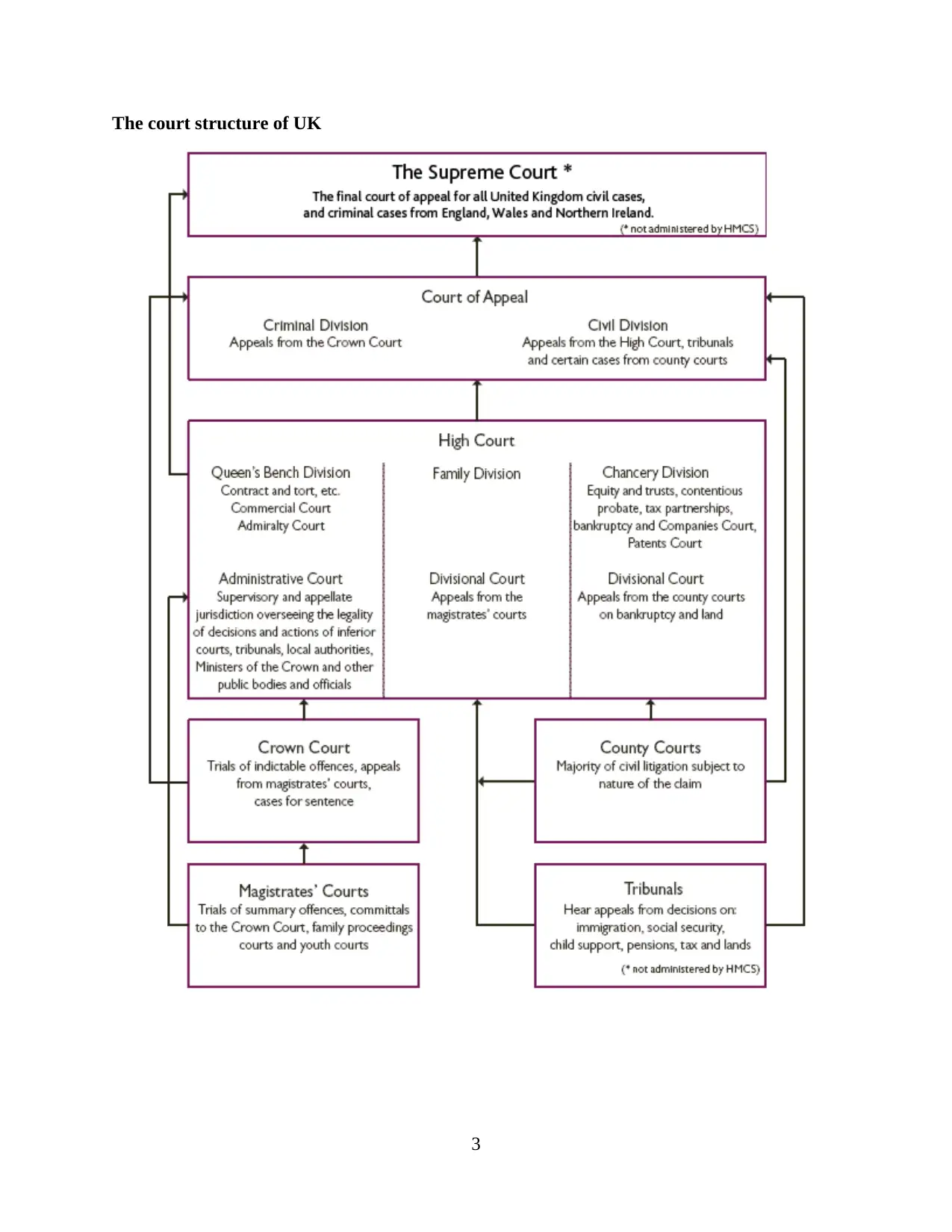
The court structure of UK
3
3

Justice system
Role of government in making law:
A draft legislation is present to the cabinet minister for approval by the political parties or
other public authorities on the matter over which the law making is proposed. The draft when
approved by the ministers is presented in the parliament to get approval as bill. The bill is
introduces to one of the house of parliament first through first reading where title the bill is read
out with given overview of what is going to be discussed. From here bill goes to the second
reading where discussion over the principles of bill is done with a voting over the decision to
carry forward the bill or not. With majority of vote bill goes to committee stage where the house
committee debate over the bill, makes changes. From here bill goes to report stage where the
house considers the changes and vote upon the same (Kraakman, 2017. Now comes the third
reading where a small debate is carries on but no changes are made and a final voting is done on
whether the bills shall be accreted or rejected. After this bill is present to another house of
parliament to consider the bill and if changes are made it is referred back to the first house and
this process goes on till both houses reach to a unanimous decision over accepting the bill. After
getting approval form both the houses the bill is presented to her Highness to get final consent
and with getting this bill converts to a law.
Organization of judiciary:
The judicial system of the English legal system covers both courts and tribunals. The
heights' authority to hear an appeal is the supreme court. Also, a concept of separation of the
power has been applied in the UK to the functions of the legislatives and executives (The Legal
System of the United Kingdom, 2018). Under the judicial system of UK there are more than 200
courts which hears case of both civil and criminal nature to provide legal remedy to the disputes,
damages or the injuries.
Impact of law
Contract law regulated the relationship between the employer and employee under
employment contract as well between the parties to the business transaction. This provides the
legal remedy for the breach of the contractual promise as compensation.
Competition law, 1998 impose prohibition on the agreements and business practices that
can risk the competition in marketplace of UK. The business organisation are not allowed to use
their domineer position to mitigate the competition as they can face serious legal consequences.
4
Role of government in making law:
A draft legislation is present to the cabinet minister for approval by the political parties or
other public authorities on the matter over which the law making is proposed. The draft when
approved by the ministers is presented in the parliament to get approval as bill. The bill is
introduces to one of the house of parliament first through first reading where title the bill is read
out with given overview of what is going to be discussed. From here bill goes to the second
reading where discussion over the principles of bill is done with a voting over the decision to
carry forward the bill or not. With majority of vote bill goes to committee stage where the house
committee debate over the bill, makes changes. From here bill goes to report stage where the
house considers the changes and vote upon the same (Kraakman, 2017. Now comes the third
reading where a small debate is carries on but no changes are made and a final voting is done on
whether the bills shall be accreted or rejected. After this bill is present to another house of
parliament to consider the bill and if changes are made it is referred back to the first house and
this process goes on till both houses reach to a unanimous decision over accepting the bill. After
getting approval form both the houses the bill is presented to her Highness to get final consent
and with getting this bill converts to a law.
Organization of judiciary:
The judicial system of the English legal system covers both courts and tribunals. The
heights' authority to hear an appeal is the supreme court. Also, a concept of separation of the
power has been applied in the UK to the functions of the legislatives and executives (The Legal
System of the United Kingdom, 2018). Under the judicial system of UK there are more than 200
courts which hears case of both civil and criminal nature to provide legal remedy to the disputes,
damages or the injuries.
Impact of law
Contract law regulated the relationship between the employer and employee under
employment contract as well between the parties to the business transaction. This provides the
legal remedy for the breach of the contractual promise as compensation.
Competition law, 1998 impose prohibition on the agreements and business practices that
can risk the competition in marketplace of UK. The business organisation are not allowed to use
their domineer position to mitigate the competition as they can face serious legal consequences.
4
⊘ This is a preview!⊘
Do you want full access?
Subscribe today to unlock all pages.

Trusted by 1+ million students worldwide
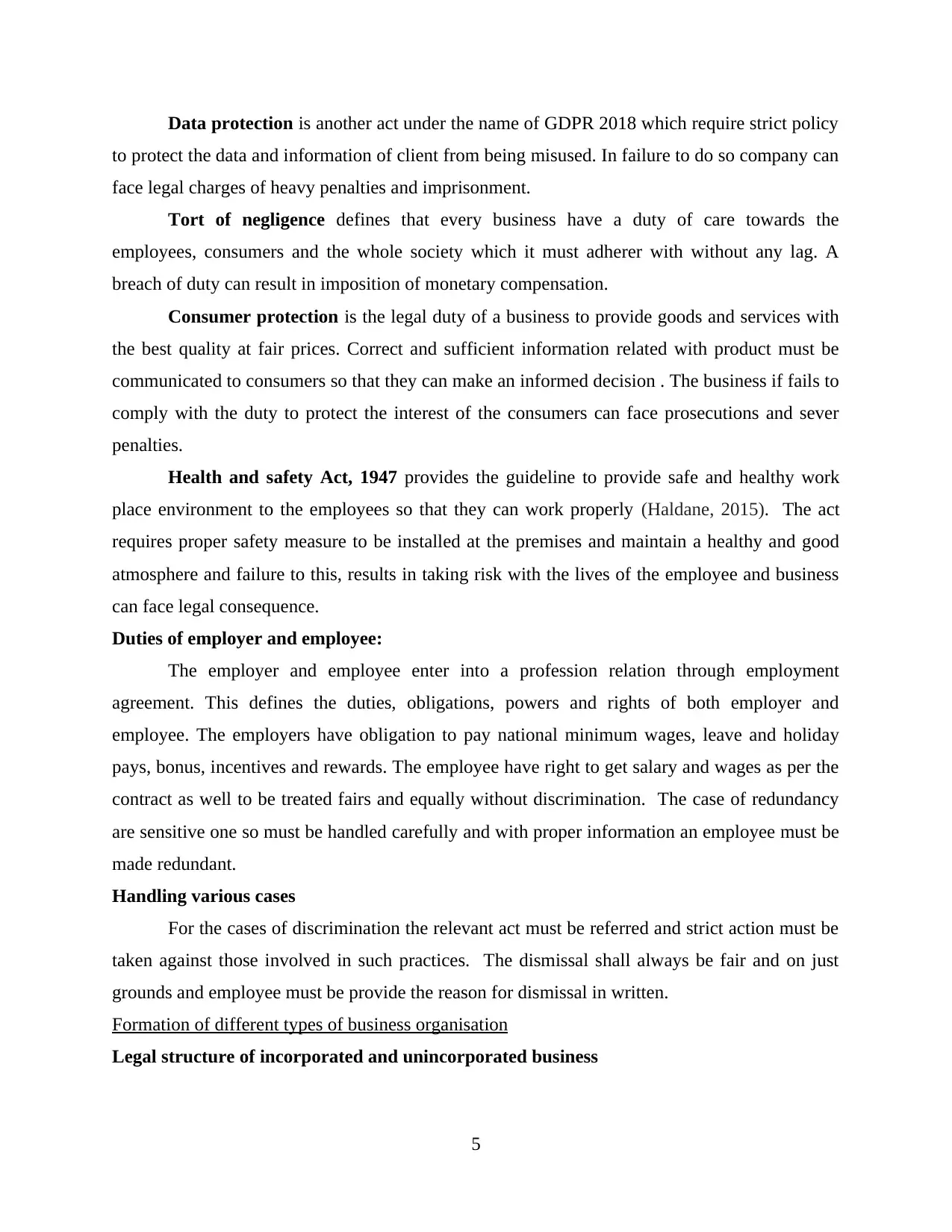
Data protection is another act under the name of GDPR 2018 which require strict policy
to protect the data and information of client from being misused. In failure to do so company can
face legal charges of heavy penalties and imprisonment.
Tort of negligence defines that every business have a duty of care towards the
employees, consumers and the whole society which it must adherer with without any lag. A
breach of duty can result in imposition of monetary compensation.
Consumer protection is the legal duty of a business to provide goods and services with
the best quality at fair prices. Correct and sufficient information related with product must be
communicated to consumers so that they can make an informed decision . The business if fails to
comply with the duty to protect the interest of the consumers can face prosecutions and sever
penalties.
Health and safety Act, 1947 provides the guideline to provide safe and healthy work
place environment to the employees so that they can work properly (Haldane, 2015). The act
requires proper safety measure to be installed at the premises and maintain a healthy and good
atmosphere and failure to this, results in taking risk with the lives of the employee and business
can face legal consequence.
Duties of employer and employee:
The employer and employee enter into a profession relation through employment
agreement. This defines the duties, obligations, powers and rights of both employer and
employee. The employers have obligation to pay national minimum wages, leave and holiday
pays, bonus, incentives and rewards. The employee have right to get salary and wages as per the
contract as well to be treated fairs and equally without discrimination. The case of redundancy
are sensitive one so must be handled carefully and with proper information an employee must be
made redundant.
Handling various cases
For the cases of discrimination the relevant act must be referred and strict action must be
taken against those involved in such practices. The dismissal shall always be fair and on just
grounds and employee must be provide the reason for dismissal in written.
Formation of different types of business organisation
Legal structure of incorporated and unincorporated business
5
to protect the data and information of client from being misused. In failure to do so company can
face legal charges of heavy penalties and imprisonment.
Tort of negligence defines that every business have a duty of care towards the
employees, consumers and the whole society which it must adherer with without any lag. A
breach of duty can result in imposition of monetary compensation.
Consumer protection is the legal duty of a business to provide goods and services with
the best quality at fair prices. Correct and sufficient information related with product must be
communicated to consumers so that they can make an informed decision . The business if fails to
comply with the duty to protect the interest of the consumers can face prosecutions and sever
penalties.
Health and safety Act, 1947 provides the guideline to provide safe and healthy work
place environment to the employees so that they can work properly (Haldane, 2015). The act
requires proper safety measure to be installed at the premises and maintain a healthy and good
atmosphere and failure to this, results in taking risk with the lives of the employee and business
can face legal consequence.
Duties of employer and employee:
The employer and employee enter into a profession relation through employment
agreement. This defines the duties, obligations, powers and rights of both employer and
employee. The employers have obligation to pay national minimum wages, leave and holiday
pays, bonus, incentives and rewards. The employee have right to get salary and wages as per the
contract as well to be treated fairs and equally without discrimination. The case of redundancy
are sensitive one so must be handled carefully and with proper information an employee must be
made redundant.
Handling various cases
For the cases of discrimination the relevant act must be referred and strict action must be
taken against those involved in such practices. The dismissal shall always be fair and on just
grounds and employee must be provide the reason for dismissal in written.
Formation of different types of business organisation
Legal structure of incorporated and unincorporated business
5
Paraphrase This Document
Need a fresh take? Get an instant paraphrase of this document with our AI Paraphraser
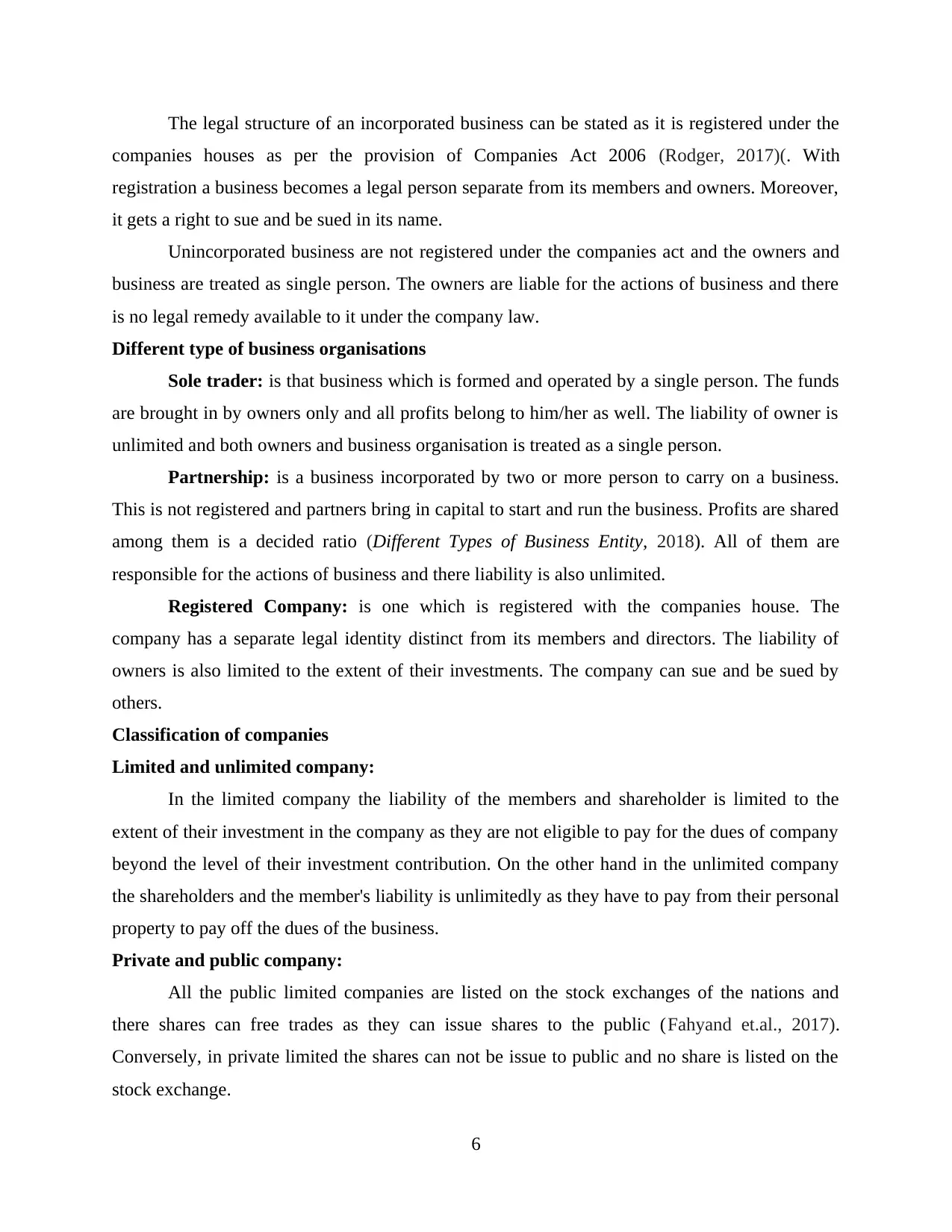
The legal structure of an incorporated business can be stated as it is registered under the
companies houses as per the provision of Companies Act 2006 (Rodger, 2017)(. With
registration a business becomes a legal person separate from its members and owners. Moreover,
it gets a right to sue and be sued in its name.
Unincorporated business are not registered under the companies act and the owners and
business are treated as single person. The owners are liable for the actions of business and there
is no legal remedy available to it under the company law.
Different type of business organisations
Sole trader: is that business which is formed and operated by a single person. The funds
are brought in by owners only and all profits belong to him/her as well. The liability of owner is
unlimited and both owners and business organisation is treated as a single person.
Partnership: is a business incorporated by two or more person to carry on a business.
This is not registered and partners bring in capital to start and run the business. Profits are shared
among them is a decided ratio (Different Types of Business Entity, 2018). All of them are
responsible for the actions of business and there liability is also unlimited.
Registered Company: is one which is registered with the companies house. The
company has a separate legal identity distinct from its members and directors. The liability of
owners is also limited to the extent of their investments. The company can sue and be sued by
others.
Classification of companies
Limited and unlimited company:
In the limited company the liability of the members and shareholder is limited to the
extent of their investment in the company as they are not eligible to pay for the dues of company
beyond the level of their investment contribution. On the other hand in the unlimited company
the shareholders and the member's liability is unlimitedly as they have to pay from their personal
property to pay off the dues of the business.
Private and public company:
All the public limited companies are listed on the stock exchanges of the nations and
there shares can free trades as they can issue shares to the public (Fahyand et.al., 2017).
Conversely, in private limited the shares can not be issue to public and no share is listed on the
stock exchange.
6
companies houses as per the provision of Companies Act 2006 (Rodger, 2017)(. With
registration a business becomes a legal person separate from its members and owners. Moreover,
it gets a right to sue and be sued in its name.
Unincorporated business are not registered under the companies act and the owners and
business are treated as single person. The owners are liable for the actions of business and there
is no legal remedy available to it under the company law.
Different type of business organisations
Sole trader: is that business which is formed and operated by a single person. The funds
are brought in by owners only and all profits belong to him/her as well. The liability of owner is
unlimited and both owners and business organisation is treated as a single person.
Partnership: is a business incorporated by two or more person to carry on a business.
This is not registered and partners bring in capital to start and run the business. Profits are shared
among them is a decided ratio (Different Types of Business Entity, 2018). All of them are
responsible for the actions of business and there liability is also unlimited.
Registered Company: is one which is registered with the companies house. The
company has a separate legal identity distinct from its members and directors. The liability of
owners is also limited to the extent of their investments. The company can sue and be sued by
others.
Classification of companies
Limited and unlimited company:
In the limited company the liability of the members and shareholder is limited to the
extent of their investment in the company as they are not eligible to pay for the dues of company
beyond the level of their investment contribution. On the other hand in the unlimited company
the shareholders and the member's liability is unlimitedly as they have to pay from their personal
property to pay off the dues of the business.
Private and public company:
All the public limited companies are listed on the stock exchanges of the nations and
there shares can free trades as they can issue shares to the public (Fahyand et.al., 2017).
Conversely, in private limited the shares can not be issue to public and no share is listed on the
stock exchange.
6
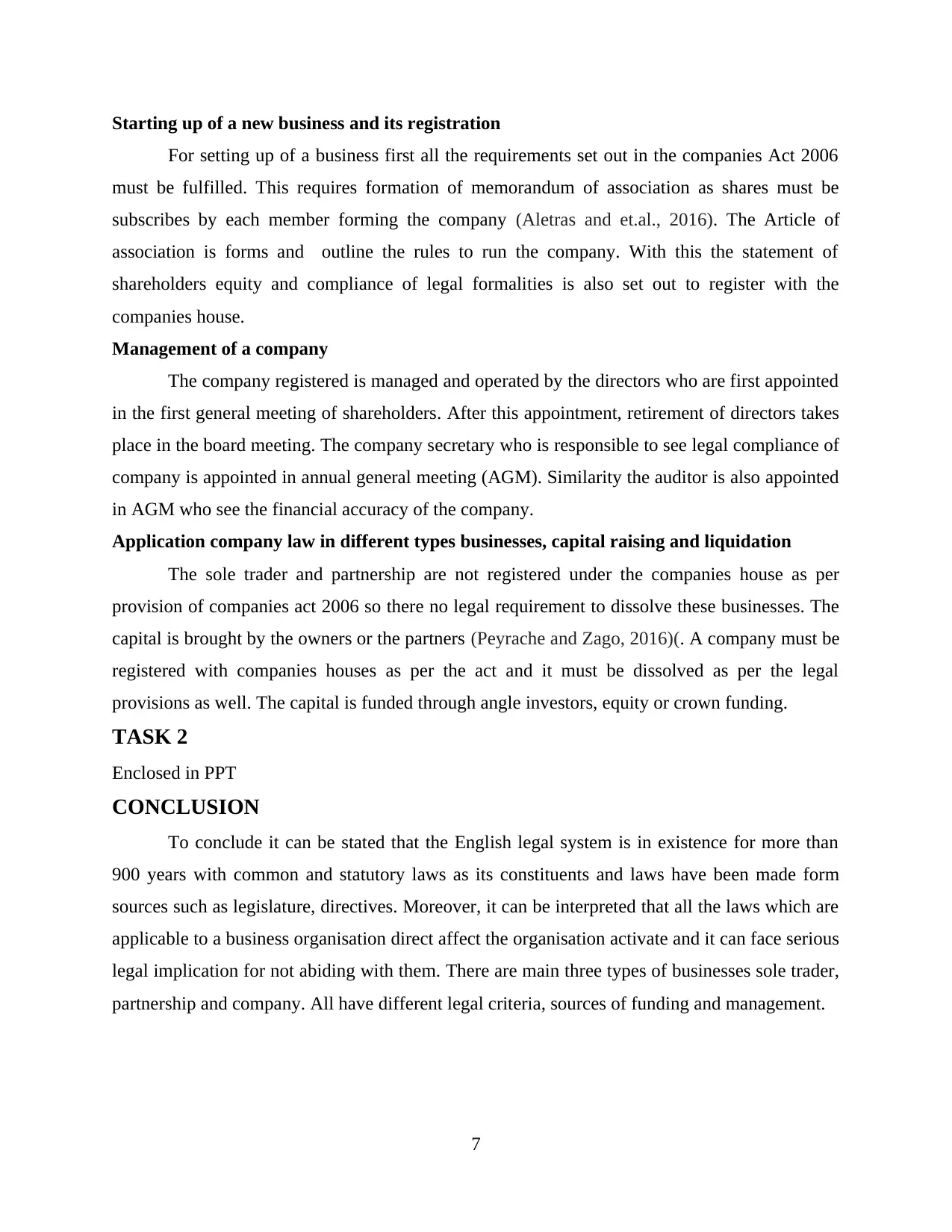
Starting up of a new business and its registration
For setting up of a business first all the requirements set out in the companies Act 2006
must be fulfilled. This requires formation of memorandum of association as shares must be
subscribes by each member forming the company (Aletras and et.al., 2016). The Article of
association is forms and outline the rules to run the company. With this the statement of
shareholders equity and compliance of legal formalities is also set out to register with the
companies house.
Management of a company
The company registered is managed and operated by the directors who are first appointed
in the first general meeting of shareholders. After this appointment, retirement of directors takes
place in the board meeting. The company secretary who is responsible to see legal compliance of
company is appointed in annual general meeting (AGM). Similarity the auditor is also appointed
in AGM who see the financial accuracy of the company.
Application company law in different types businesses, capital raising and liquidation
The sole trader and partnership are not registered under the companies house as per
provision of companies act 2006 so there no legal requirement to dissolve these businesses. The
capital is brought by the owners or the partners (Peyrache and Zago, 2016)(. A company must be
registered with companies houses as per the act and it must be dissolved as per the legal
provisions as well. The capital is funded through angle investors, equity or crown funding.
TASK 2
Enclosed in PPT
CONCLUSION
To conclude it can be stated that the English legal system is in existence for more than
900 years with common and statutory laws as its constituents and laws have been made form
sources such as legislature, directives. Moreover, it can be interpreted that all the laws which are
applicable to a business organisation direct affect the organisation activate and it can face serious
legal implication for not abiding with them. There are main three types of businesses sole trader,
partnership and company. All have different legal criteria, sources of funding and management.
7
For setting up of a business first all the requirements set out in the companies Act 2006
must be fulfilled. This requires formation of memorandum of association as shares must be
subscribes by each member forming the company (Aletras and et.al., 2016). The Article of
association is forms and outline the rules to run the company. With this the statement of
shareholders equity and compliance of legal formalities is also set out to register with the
companies house.
Management of a company
The company registered is managed and operated by the directors who are first appointed
in the first general meeting of shareholders. After this appointment, retirement of directors takes
place in the board meeting. The company secretary who is responsible to see legal compliance of
company is appointed in annual general meeting (AGM). Similarity the auditor is also appointed
in AGM who see the financial accuracy of the company.
Application company law in different types businesses, capital raising and liquidation
The sole trader and partnership are not registered under the companies house as per
provision of companies act 2006 so there no legal requirement to dissolve these businesses. The
capital is brought by the owners or the partners (Peyrache and Zago, 2016)(. A company must be
registered with companies houses as per the act and it must be dissolved as per the legal
provisions as well. The capital is funded through angle investors, equity or crown funding.
TASK 2
Enclosed in PPT
CONCLUSION
To conclude it can be stated that the English legal system is in existence for more than
900 years with common and statutory laws as its constituents and laws have been made form
sources such as legislature, directives. Moreover, it can be interpreted that all the laws which are
applicable to a business organisation direct affect the organisation activate and it can face serious
legal implication for not abiding with them. There are main three types of businesses sole trader,
partnership and company. All have different legal criteria, sources of funding and management.
7
⊘ This is a preview!⊘
Do you want full access?
Subscribe today to unlock all pages.

Trusted by 1+ million students worldwide

REFERENCES
Books and Journal
Knapp, C. L., Crystal, N. M. and Prince, H. G., 2019. Problems in Contract Law: cases and
materials. Wolters Kluwer.
Aletras, N. and et.al., 2016. Predicting judicial decisions of the European Court of Human
Rights: A natural language processing perspective. PeerJ Computer Science. 2. p.e93.
Peyrache, A. and Zago, A., 2016. Large courts, small justice!: The inefficiency and the optimal
structure of the Italian justice sector. Omega. 64. pp.42-56.
Kraakman, R., 2017. The anatomy of corporate law: A comparative and functional approach.
Oxford University Press.
Haldane, A., 2015, May. Who owns a company?. In Speech, University of Edinburgh Corporate
Finance Conference, May 22nd.
Rodger, B., 2017. Competition law private enforcement in the UK courts: case-law
developments 2013-2016. Global Competition Litigation Review.
Fahy, N and et.al., 2017. How will Brexit affect health and health services in the UK?
Evaluating three possible scenarios. The Lancet. 390(10107). pp.2110-2118.
Online
The English Legal System. 2018. [Online]. Available through :<https://www.apprendre-le-
droit.fr/anglais-juridique/the-english-legal-system/>.
The Legal System of the United Kingdom. 2018. [Online]. Available through
:<https://www.cilex.org.uk/about_cilex/about-cilex-lawyers/what-cilex-lawyers-do/the-uk-
legal-system>.
Different Types of Business Entity.2018. [Online]. Available through
:<https://www.completeformations.co.uk/companyfaqs/business_entities/types.html>.
8
Books and Journal
Knapp, C. L., Crystal, N. M. and Prince, H. G., 2019. Problems in Contract Law: cases and
materials. Wolters Kluwer.
Aletras, N. and et.al., 2016. Predicting judicial decisions of the European Court of Human
Rights: A natural language processing perspective. PeerJ Computer Science. 2. p.e93.
Peyrache, A. and Zago, A., 2016. Large courts, small justice!: The inefficiency and the optimal
structure of the Italian justice sector. Omega. 64. pp.42-56.
Kraakman, R., 2017. The anatomy of corporate law: A comparative and functional approach.
Oxford University Press.
Haldane, A., 2015, May. Who owns a company?. In Speech, University of Edinburgh Corporate
Finance Conference, May 22nd.
Rodger, B., 2017. Competition law private enforcement in the UK courts: case-law
developments 2013-2016. Global Competition Litigation Review.
Fahy, N and et.al., 2017. How will Brexit affect health and health services in the UK?
Evaluating three possible scenarios. The Lancet. 390(10107). pp.2110-2118.
Online
The English Legal System. 2018. [Online]. Available through :<https://www.apprendre-le-
droit.fr/anglais-juridique/the-english-legal-system/>.
The Legal System of the United Kingdom. 2018. [Online]. Available through
:<https://www.cilex.org.uk/about_cilex/about-cilex-lawyers/what-cilex-lawyers-do/the-uk-
legal-system>.
Different Types of Business Entity.2018. [Online]. Available through
:<https://www.completeformations.co.uk/companyfaqs/business_entities/types.html>.
8
1 out of 10
Related Documents
Your All-in-One AI-Powered Toolkit for Academic Success.
+13062052269
info@desklib.com
Available 24*7 on WhatsApp / Email
![[object Object]](/_next/static/media/star-bottom.7253800d.svg)
Unlock your academic potential
Copyright © 2020–2025 A2Z Services. All Rights Reserved. Developed and managed by ZUCOL.





